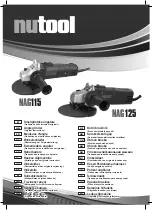
PMNF 1350 B2
GB
│
5
■
d)
Grinding tools should only be used for the
recommended applications. For example:
Never grind with the side surface of a cutting
disc.
Cutting discs are designed to remove
material with the edge of the disc. Any lateral
application of force on these grinding tools can
lead to breakage.
e)
Always use an undamaged clamping flange
of the correct size and shape for the selected
grinding disc.
Suitable flanges support the
grinding disc and reduce the risk of disc break-
age.
f)
The external diameter and thickness of the
accessory tool used must comply with the
dimensions of your power tool.
Incorrectly
dimensioned accessory tools cannot be suffi-
ciently shielded or controlled.
g)
Grinding discs and flanges must fit precisely
onto the grinding spindle of your power tool.
Accessory tools which do not fit precisely on
the grinding spindle of the power tool will rotate
unevenly, vibrate severely and can lead to a
loss of control.
h)
Do not use damaged grinding discs. Check
the grinding discs before each use for chips
and cracks. If the power tool or grinding disc
is dropped, check to see if it either are dam-
aged, or use an undamaged grinding disc.
After checking and inserting the grinding
disc, ensure that you and any other people
in the vicinity remain outside of the range of
the rotating grinding disc, and allow the tool
to rotate at maximum speed for one minute.
Damaged grinding discs usually break during
this test period.
i)
Wear personal protective equipment.
Depending on the application, ensure that
you use full face protection, eye protection
or goggles. If required, use a dust mask, ear
protectors, protective gloves or special apron
to protect you from grindings and material
particles.
Eyes should be protected from flying
debris that may be generated during certain
applications. Dust or filter masks must filter
any dust created by the application. If you are
exposed to loud noise for any length of time,
you can suffer a hearing loss.
j)
Ensure that other people remain at a safe dis-
tance to your workspace. Anyone who enters
the workspace must wear personal protective
equipment.
Fragments of the workpiece or bro-
ken accessory tools can fly off and cause injury
– even outside the immediate working area.
k)
Hold power tool by the insulated gripping
surfaces, when performing an operation
where the accessory tool may contact hidden
wiring or its own cord.
Contact with a "live"
wire may make exposed metal parts of the pow-
er tool "live" and could give the operator an
electric shock.
l)
Keep the power cord away from any rotating
accessories.
If you lose control of the appliance,
the cord may get cut or caught and your hand or
arm could get caught in the rotating accessory
tool.
m)
Never put the power tool down until the acces-
sory tool has come to a complete standstill.
The rotating accessory tool could come into
contact with the surface and cause you to lose
control of the power tool.
n)
Do not leave the power tool running whilst
carrying it.
Accidental contact between your
clothing and the rotating accessory tool could
cause your clothing to get caught and the ac-
cessory tool to penetrate a part of your body.
o)
Clean the ventilation slits of your power tool
regularly.
The engine fan draws dust into the
housing and a strong accumulation of metal
dust can cause electrical hazards.
p)
Do not use the power tool in the vicinity of
flammable materials.
Sparks can ignite such
materials.
q)
Do not use any accessory tools which require
liquid coolant.
The use of water or other liquid
coolants may lead to electric shock.
Summary of Contents for PMNF 1350 B2
Page 3: ... I 0 ...
Page 4: ...A B C D E ...
Page 5: ...5 17 14 13 17 14 13 5 Ok F 5 17 14 13 Ok 14 G ...
Page 17: ...PMNF 1350 B2 12 GB ...
Page 31: ...PMNF 1350 B2 26 HU ...
Page 43: ...PMNF 1350 B2 38 SI ...











































